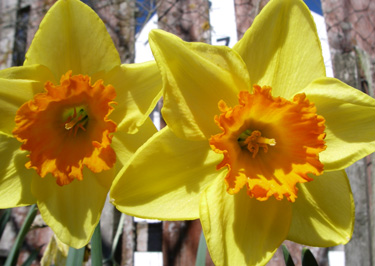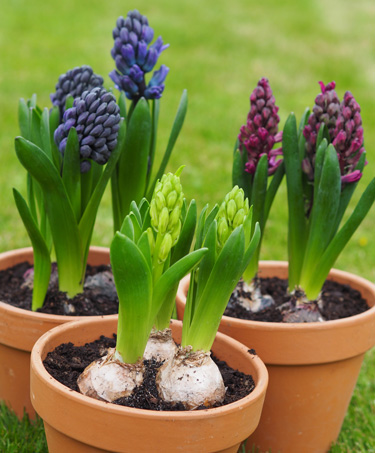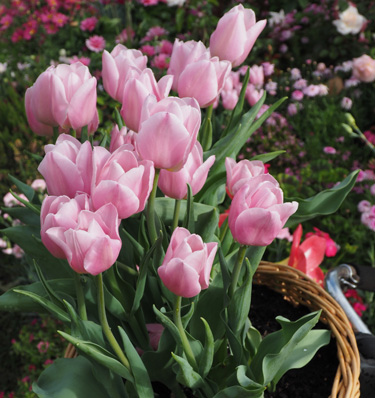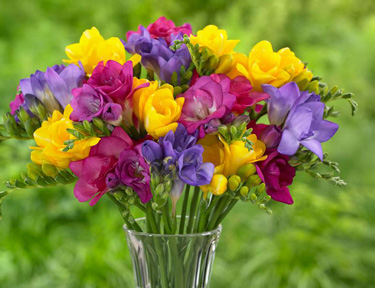The sweet promise of spring
Take some little brown bulbs and plant them in some well-drained soil. In just a few months time nature’s little brown parcels will morph into a magnificent bloom. The sheer anticipation of what’s to come makes winter feel a little less glum.
Autumn is planting time for the bulbs that bloom over late winter and spring. Bulbs are easy to grow and come with their own packed lunch. The most essential ingredient for bulb success is perfectly drained soil or potting mix. But don’t despair, if your soil lies heavy and wet in winter, plant your bulbs in a raised garden bed or opt for pots. Bulbs and pots were made for each other!
Even when growing bulbs in the garden, it’s a good idea to contain them in buried baskets. This trick makes life easy of you want to lift and store your bulbs after flowering. But be aware that you must first let your bulb foliage die down naturally if you want to keep them for flowering next year.
Golden daffodils
Daffodils radiate sunshine colour and fragrance into the last days of winter. These spring icons are gifts from the northern hemisphere, Spain and Portugal in particular, and they grow well throughout New Zealand.
Daffodils are favourites for ‘naturalising ’ under trees but they also look great in pots. Prepare several pots at ten day intervals for a continuous display. You can bring them indoors to a sunny warm position as their green shoots pop up. Those you planted later can be waiting in the wings for a later display.
To get the best from daffodils planted in the garden, apply bulb fertiliser and mix it thoroughly with the soil before planting. To sweeten very acidic soils add some dolomite lime too (about 100g per square metre).
Beautiful blues
Bright blue grape hyacinths (Muscari) grow easily in any climate and make a stunning colour contrast to yellow daffodils. Elegant Dutch irises, in shades of blue, yellow and white, will also flower beautifully in most parts of the country as long as they have excellent drainage and plenty of sunshine.
Bulbs that love the cold
In their Northern Hemisphere homelands, tulips, hyacinths and crocus flowers are often seen popping up through the snow. These beauties rely on the long winter chill to activate flowering. In parts of the world where winter is not cold enough or long enough gardeners get around this by tricking bulbs with a ‘false winter’. With insufficient chilling tulips may still bloom, but with flowers hiding among the leaves on short stunted stems.
Maximise your tulips’ flowering performance by storing bulbs in the fridge for six to eight weeks before planting. Make sure there are no fruits in with your tulip bulbs. The ethylene gas fruits emit is detrimental to flower production.
Tulips can be enjoyed in any climate when fresh bulbs are planted each year. In the likes of Central Otago, where winter more closely compares to their natural habitat, tulip bulbs may be left in the ground to flower in subsequent years, or lifted and stored over summer once the foliage has died down.
For hyacinths and crocus, a good winter chill is needed for root development. In a cold climate it will be enough to place pots outdoors or bury them in the coldest part of garden. In a warm climate potted bulbs can be placed in the fridge for several weeks or the pots kept in the coolest location outdoors and periodically topped with ice. When flower buds appear, pots can be moved to pride of place with plenty of natural light but the flowers will last longer if kept cool.
Bulbs from warm winter climates
South African native bulbs, such as Freesia, Lachenalia and Sparaxis are ideally suited to New Zealand’s warmer climates. And, provided the soil is not too wet over summer, they can be left in the garden to pop up year after year. They may also be left in their pots for two or three years without repotting. These frost tender treasures are easily grown in cold climates by growing them in pots or planting in spring (after the last frost) for summer flowering.
Plant freesias in batches every one or two weeks for a succession flowers indoors or out. They flower eight weeks after planting, and continue to bloom for up to eight weeks. For a stunning show in a hanging basket plant lachenalias over the entire basket with the point of each bulb facing outwards. The flowers will find their own way upright once sprouted.
Perfect for picking
Modern poppy-flowered anemones and ranunculus with bright double peony-like flowers were specially bred for cut flower growers with striking coloured blooms on good strong stems and a long vase life. They grow from oddly shaped little tubers which can be planted as soon as they become available in late summer. Plant some every two or three weeks from February to May for a continuous supply of flowers for picking from mid-winter through spring.
Be sure to keep up with watering if planting these bulbs while the weather is still dry. A 5cm layer of mulch will help protect them from hot summer heat. Plant anemone tubers with their pointed side downwards, and ranunculus with their claws facing downwards. Soak tubers in water for a few hours prior to planting.
Good companions - what to plant with spring bulbs
| Foliage plants | Flowering plants | Trees & shrubs |
| Hostas | Pansies | Camellias |
| Hellebores | Primula | Magnolia |
| Heuchera | Phlox | Buxus |
| Ferns | Stock | |
| Brunnera | Violas | |
| Forget-me-not | ||
| Alyssum | ||
| Wallflowers |

28-Feb-2021

Daffodils

Hyacinths in terracotta pots

Tulips love cooler temperatures

Scented freesias are great for picking

Anemones come in lovely colours and are good vase companions

